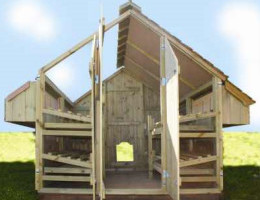Building a chicken coop is simple compared to building a house, but no less important to the chicken than your house is to you. Keeping this in mind, building plans for a chicken coop should take a few things into consideration. In fact, I’m going to lay out 8 categories for you to consider before you go off and start pounding nails.
Is that even a thing anymore? I use screws for all of my building projects.
These are not in order of importance. I just feel that they should all be considered if you want to make your chickens as comfortable, thus productive, as possible.
Size
Consider the number of chickens you have and make sure the coop is large enough for them to move around freely. This is important since overcrowding can lead to
- A lot of pecking and feather picking. You don’t want bald birds, and the stress related to these activities will reduce productivity.
- Cannibalism. If you don’t keep the chicken/space ratio in order, the chickens will make their own space.
- Fighting.
- A very filthy coop.
- Toppled feeders and waterers.
- Illness and disease. The closer packed the chickens are, the easier it is for critters like lice and mites to travel from bird to bird.
Now, the other thing is that you don’t want so much room that the chickens can’t naturally keep warm in the winter if that is an issue. For ultimate overall comfort, you want about 4 square feet per chicken in your coop. Less for Bantams, more for Jersey Giants.
Chicken Coop Materials
It doesn’t matter if you make your chicken coop out of wood, plastic, or metal. The material has to be durable. It has to be able to withstand wind, rain, snow, hail, snow on the roof, and most of all, predators.
Wood is an obvious favorite for its durability, ease of workmanship, and possibly aesthetics (who am I to judge?).
Redwood and Cedar are great choices for rot and insect resistance. Treated lumber is durable too, but the chemicals in the wood aren’t good for the chickens.
Metal is tough and durable, but can get mighty hot in the summer, and just as cold in the winter. Insulation is key when using metal.
Plastic ticks a lot of boxes. It’s light. It’s easy to clean. The termites and powder post beetles aren’t going to bother it. The problem is with durability, and it’s not pleasant to work with, or repair. In the end, the choice is up to you.
===> Get Plans on How To Build a Chicken Coop Here <===
Chicken Coop Ventilation
Chicken poop gives off ammonia gas. Ammonia gas can irritate and burn the skin, mouth, throat, lungs, and eyes. In higher amounts it can damage the lungs and even cause death. You don’t want that. It’s hard getting eggs that way – just sayin’.
You want two or three vent ports in your coop. They should be up toward the peak since heat and ammonia gas rises.
Vents must be predator-proof. A sturdy metal cloth should do the trick over every vent. Remember that a mink can get through a hole the size of a quarter.
Chicken Coop Accessibility
Yours and theirs – There are two main functions of good accessibility to the inside of your coop. The first is to gather eggs, and the second is to clean it.
Whatever the reason for entering the coop, you don’t want it to be a chore unto itself. You will not enjoy bumping your head with every shovelful of golden compost maker that you carry to the wheelbarrow.
You will also want enough room getting a wall-to-wall roost, or two, or three in there. Nesting boxes will need to be installed as well.
Are you getting the idea that you need a real person-door in your coop? I hope so.
Chicken Run Area
chickens love to be outside. If you are not going to free-range your chickens, then the next best thing is a run. A run has one advantage over free-ranging. You can keep your chickens safe from predators as long as it is built right.
In the run, your chickens should have about 10 square feet of space to play around in. They will peck and scratch the ground, dig dust bath holes, and stretch their wings a little, so the more space, the better.
The walls of the run must be sturdy enough to stop predators. I like to think that if it will stop a dog, it will stop almost anything. Fencing has to be buried at least six-inches to prevent digging under it. You can’t stop a bear, but you can slow it down long enough to scare it away if you have to.
The top of the run must be protected from aerial attacks. Wire is preferable to fabric netting.
Shade can be provided in the form of tarps, or you can build under a shade tree.
Put objects in the run for the chickens to “play” with like perches, logs, cardboard boxes, hay bales, plastic balls, and anything to make a chicken’s life interesting.
Of course, food and water must always be available to your chickens. Even in the run.
What to do About Predators
Let’s face it… Chickens are yummy. They are on almost every predators menu. Chicken predators include, but are not limited to:
- Hawks and Eagles
- Foxes while raising kits
- Domestic cats
- Mink and Weasels
- Snakes
- Bears
Nighttime predators:
- Fox, Coyotes
- Raccoon
- Mink, Weasels, Opossums
- Fishers
- Skunks
- Bears
- Owls at dusk
Look for coops that have safety features such as sturdy latches, secure doors, and predator-proof wire mesh. I have a motion-activated solar light on my coop. This little trick can help scare off some animals, but not all of them. What it does do is alert me that something is outside of my coop.
Building With Climate in Mind
The materials you choose to build your coop should reflect the climate that you live in. Keeping in mind that you have to keep chickens warm in cold weather and cool in hot weather, the way a coop is built can be the difference between life and death for your birds.
Insulation works to keep heat out as well as in. It doesn’t matter if it’s spray foam, fiberglass, foam, or whatever, it will have to be covered. Chickens will eat insulation if allowed getting to it. They just don’t know any better.
You don’t want to make your coop too tight. Remember that ventilation is important.
What’s The Cost
Your budget determines how elaborate you want to get with your coop. A 10’x10′ box is fine as far as the chickens are concerned, but some may want to dress up their coops with weather vanes, solar heating, heated perches, thermal windows, etc.
The aesthetics of the coop are a matter of personal preference. I’ve seen coops that are built to be a mini replica of the owner’s house. I’ve seen other’s that could hardly be called a building. Whatever you build, do so making sure not to break the bank.
In conclusion, building your own chicken coop is a very satisfying project. You can build it the way you want it, to suit your needs.
I hope this information has been helpful. If it has, please leave me a message below to let me know.



Thanks for LAYING (I got the joke!) out eight considerations for building a chicken coop. I didn’t even think about domestic cats as predators to chickens. I also didn’t think about chickens eating the insulation – you mentioned we could use spray foam or fiberglass. What do you suggest we cover it with that the chickens can’t get into? Do we have to worry about them eating plastic balls/toys we put out, too?
Hey Kate, I try to inject a little humor into my posts, subtle or otherwise. I had a half-sheet of foam board glued to the side of my garage in case the car door swung out too far. The chickens wouldn’t stop eating it, so I had to take it down (not a pun).
Covering for insulation should be done with smooth sheeting. Plastic panels, wood paneling, painted plywood are all good options. It pays to go the extra mile when building, or buying a chicken coop. One of the reasons for “smooth” is to keep any infestations from getting into nooks and crannies. If you’ve ever seen a mite infestation, you know what I mean. Smooth is also easy to clean.
Toys should be made of hard plastic, and not small enough for a chicken to swallow. I hope that makes sense.
Dave
Hey, this is top-notch. I read your post and it was comprehensive and clear. I was looking for a method and a survey to build my chicken coop on my farm, I think I will make it out of wood. It looks great and in summer it doesn’t get too hot. The point that you mentioned and I like it, is the chicken run area. Thank you for sharing this post with us.
You bet, Liam, you’re very welcome. I have to be honest, though. I grew up in the era of the wooden chicken coop. Although I tried to be objective in the article, my heart lies with a barn-red, white-trimmed coop with a ramp out of the chicken door straight into the barnyard. And, as fate would have it, that is what I have x2. I’m fortunate to be in an area where there are few predators, so I free-range.
So, I agree with your choice. Other things to consider are waterers, feeders, run material, bedding, possibly incubator, and brooder. Most folk don’t realize what goes into raising chickens. It’s not just a coop and some birds. I love it.
Take care, Liam. I hope you find my site useful for other chicken related info.